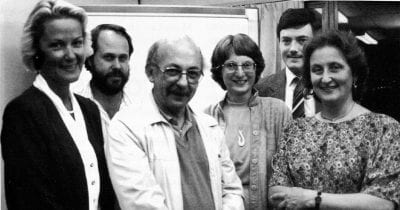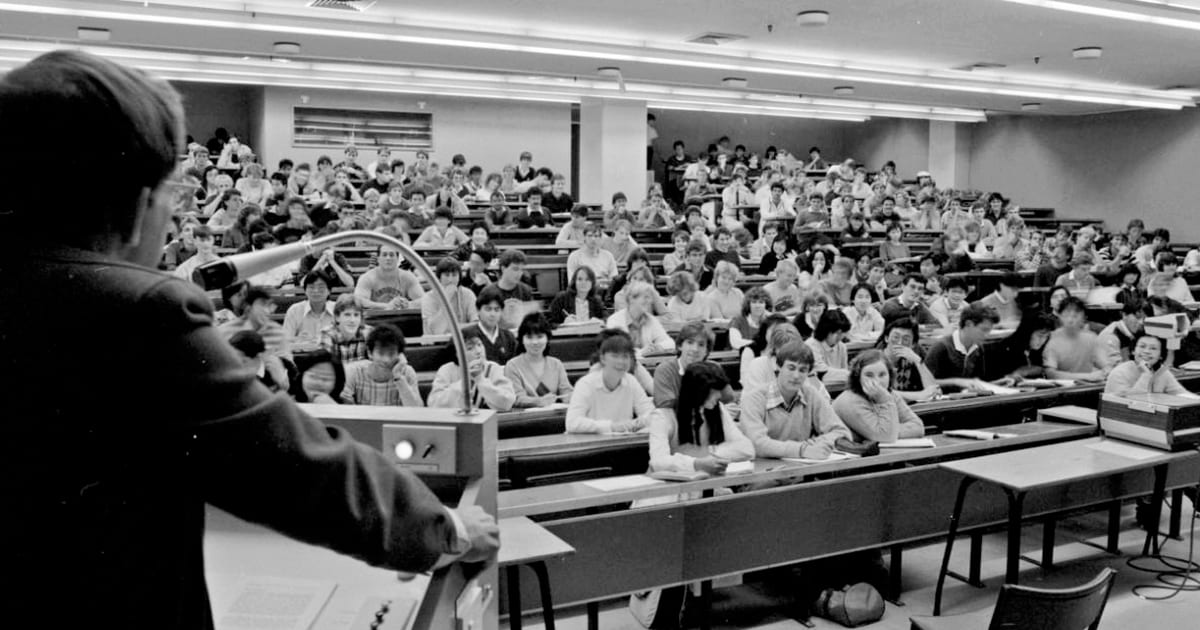Teaching before PowerPoint, Canvas and Zoom
The lecture slot, starting just after and finishing just before the hour, has remained a constant during the University of Auckland’s 140 years. Students’ and academics’ weeks are punctuated by these timetabled bursts of teaching activity. Sitting in a large lecture theatre, pen and notebook at the ready, has been a rite of passage for students transitioning from high school to ‘uni’ since 1883; technology and pedagogy have evolved over time, but the ‘sage on the stage’ lecturing style has persisted.
To mark the 140th anniversary of the University, archival photographs and artefacts from the second half of the 20th century — on display outside Special Collections in the General Library — document the familiar motifs of university teaching in the pre-digital age.
Walk, talk and chalk
The humble piece of white chalk was the most common teaching tool well into the 20th century. The ‘walk, talk and chalk’ lecturing technique was simple yet effective. Visual props in lectures were limited generally to large maps, posters of the Periodic Table and lantern slides projected onto a screen. An Audio-Visual Unit was set up in 1973 to accommodate new technologies. Larger lecture theatres were equipped by the late 1970s with film, video and overhead projectors, audio systems, and lectern microphones to enhance the learning experience.

Associate Professor Mervyn Rosser demonstrates ‘walk, talk and chalk’ in an Engineering lecture from the 1960s. Photographer Anton Estie.
Lecturing techniques to teaching excellence
How academics delivered their lectures only came under formal scrutiny in the late 1960s. For example, Robert Muldoon, Minister of Finance, questioned the costs to the taxpayer of one-third of students not finishing their degree courses.1 The first unit at the University dedicated to improving university teaching was established in 1974. Educators were concerned that new students, who had grown up watching television, had different attention spans and presentation expectations to earlier generations. AUSA began publishing its own acerbic reviews of courses and teaching in the Anti Calendar in the 1970s before departments started handing out course and lecturer evaluation forms.
Richard Gyde, AUSA’s Education Officer, offered advice to lecturers on how to avoid the ‘50-minute [lecture] monologue’ in July 1972 University News:
“Lecturers who introduce themselves at the beginning of the course, and state their topic and point of view, present a positive approach… Genuine interest in the topic on the part of the lecturer is usually transmitted to the students, while indifference results in lack of enthusiasm and less work… Most important, lectures should start and end on time.” 2
Formal evaluation of university teaching by students offered lecturers and departments more insight into how students were responding to classes. More teaching workshops were offered by the University to help lecturers improve their techniques during the 1970s and 1980s. The University finally, more than 100 years after its foundation, started to acknowledge in 1992 its outstanding lecturers by presenting annual teaching excellence awards to staff whose prowess in the classroom was recognised by students and colleagues alike.3

Six of the first recipients of the University Distinguished Teaching Awards. From left: Dianne McCarthy, Dave Lambert, Duncan McLennan, Sheila Woodgate, Gerard Rowe and Judy Brittain.
Discover more
- To learn more about University teaching, visit Special Collections, Level G, General Library | Te Herenga Mātauranga Whānui until Friday 25 August.
Ian Brailsford, Special Collections
References
1 Gustafson, B. (2000), His Way: A Biography of Robert Muldoon. Auckland University Press, Auckland, 106‐10.
2 Gyde, R. (1972). Some student ideas on teaching methods. University News, Vol. 2, No. 5, July, 11-13.
3 University News, Vol. 23, No. 4, May 1992, 7.
Featured image: Management Studies lecture in General Library B28, 1985. History of the University Auckland photography collection item 480197.

